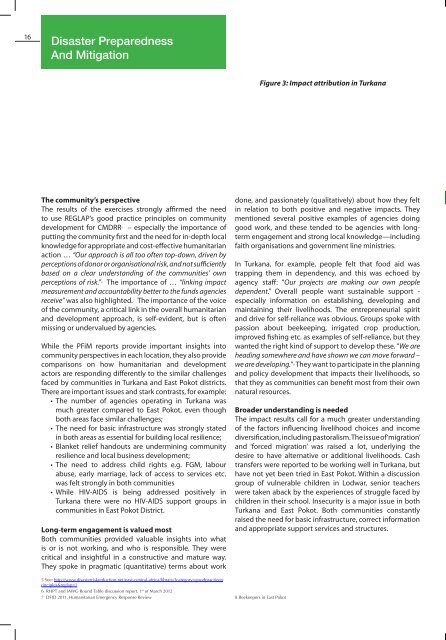Download PDF - ReliefWeb
Download PDF - ReliefWeb
Download PDF - ReliefWeb
- No tags were found...
Create successful ePaper yourself
Turn your PDF publications into a flip-book with our unique Google optimized e-Paper software.
16 17Disaster PreparednessAnd MitigationResearchFigure 3: Impact attribution in TurkanaConclusionsCommunities in the front line of disasters have deep insightsand understanding of their context: Strategies and policesshould be directly informed by these communities so thatthey are locally owned. Good new ideas should always befully communicated and discussed with communities toensure that they are appropriate and adapted to the localcontext: Some agencies are getting this communicationright and some are not. The socio, economic and politicallife of communities is rich and varied, and they know whoand what works best for them. It is the organisations thathave long-term, relevant relationships with communitiesthat are often getting it right as they understand andrespect the local context. This should be the norm, not theexception.For further information please contact:Email: contact@p-fim.orgLinkedIn: http://www.linkedin.com/pub/people-firstimpact-method-p-fim/53/339/841The community’s perspectiveThe results of the exercises strongly affirmed the needto use REGLAP’s good practice principles on communitydevelopment for CMDRR 5 – especially the importance ofputting the community first and the need for in-depth localknowledge for appropriate and cost-effective humanitarianaction … “Our approach is all too often top-down, driven byperceptions of donor or organisational risk, and not sufficientlybased on a clear understanding of the communities’ ownperceptions of risk.” 6 The importance of … “linking impactmeasurement and accountability better to the funds agenciesreceive” was also highlighted. 7 The importance of the voiceof the community, a critical link in the overall humanitarianand development approach, is self-evident, but is oftenmissing or undervalued by agencies.While the PFiM reports provide important insights intocommunity perspectives in each location, they also providecomparisons on how humanitarian and developmentactors are responding differently to the similar challengesfaced by communities in Turkana and East Pokot districts.There are important issues and stark contrasts, for example:• The number of agencies operating in Turkana wasmuch greater compared to East Pokot, even thoughboth areas face similar challenges;• The need for basic infrastructure was strongly statedin both areas as essential for building local resilience;• Blanket relief handouts are undermining communityresilience and local business development;• The need to address child rights e.g. FGM, labourabuse, early marriage, lack of access to services etc.was felt strongly in both communities• While HIV-AIDS is being addressed positively inTurkana there were no HIV-AIDS support groups incommunities in East Pokot District.Long-term engagement is valued mostBoth communities provided valuable insights into whatis or is not working, and who is responsible. They werecritical and insightful in a constructive and mature way.They spoke in pragmatic (quantitative) terms about workdone, and passionately (qualitatively) about how they feltin relation to both positive and negative impacts. Theymentioned several positive examples of agencies doinggood work, and these tended to be agencies with longtermengagement and strong local knowledge—includingfaith organisations and government line ministries.In Turkana, for example, people felt that food aid wastrapping them in dependency, and this was echoed byagency staff: “Our projects are making our own peopledependent.” Overall people want sustainable support -especially information on establishing, developing andmaintaining their livelihoods. The entrepreneurial spiritand drive for self-reliance was obvious. Groups spoke withpassion about beekeeping, irrigated crop production,improved fishing etc. as examples of self-reliance, but theywanted the right kind of support to develop these. “We areheading somewhere and have shown we can move forward –we are developing.” 8 They want to participate in the planningand policy development that impacts their livelihoods, sothat they as communities can benefit most from their ownnatural resources.Broader understanding is neededThe impact results call for a much greater understandingof the factors influencing livelihood choices and incomediversification, including pastoralism. The issue of ‘migration’and ‘forced migration’ was raised a lot, underlying thedesire to have alternative or additional livelihoods. Cashtransfers were reported to be working well in Turkana, buthave not yet been tried in East Pokot. Within a discussiongroup of vulnerable children in Lodwar, senior teacherswere taken aback by the experiences of struggle faced bychildren in their school. Insecurity is a major issue in bothTurkana and East Pokot. Both communities constantlyraised the need for basic infrastructure, correct informationand appropriate support services and structures.People want sustainable support for maintaining their livelihoodsP-FiM.5 See: http://www.disasterriskreduction.net/east-central-africa/library/?category=goodpracticeprinciples®lap=16 RHPT and IAWG Round Table discussion report, 1 st of March 20127 DFID 2011, Humanitarian Emergency Response Review8 Beekeepers in East Pokot
















